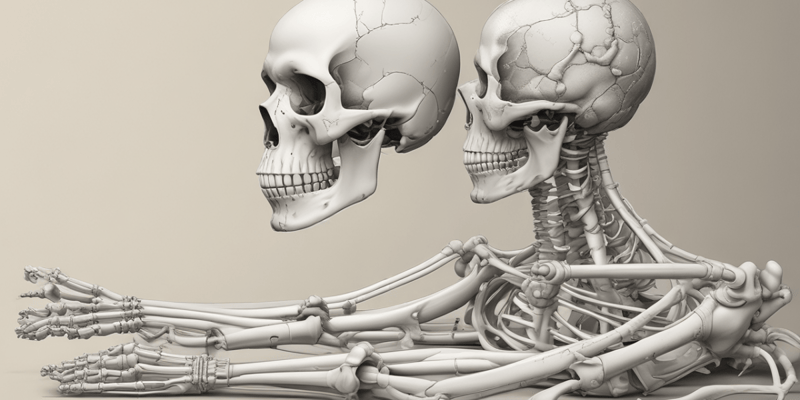Questions and Answers
What feature of synovial joints allows for a wide range of movements?
In osteoarthritis, the primary issue arises from damage to which component of the joint?
Rheumatoid arthritis is characterized by an increase in what within the synovial cavity?
Which statement accurately describes rheumatoid arthritis?
Signup and view all the answers
The discomfort experienced in osteoarthritis occurs mainly due to a lack of what?
Signup and view all the answers
What is a common misconception about rheumatoid arthritis?
Signup and view all the answers
What condition is primarily characterized by low calcium levels leading to weak bones?
Signup and view all the answers
Which of the following connective tissues primarily connects muscles to bones?
Signup and view all the answers
What type of joint allows for very little to no movement, such as those found in the skull?
Signup and view all the answers
What component of the skeletal system is made up of cells, collagen, and a matrix, providing support and flexibility?
Signup and view all the answers
Which connective tissue helps in connecting bones together and is rich in collagen and elastin?
Signup and view all the answers
What is the primary role of the axial skeleton?
Signup and view all the answers
Which of the following joints is characterized as slightly movable and can be found in the spine?
Signup and view all the answers
What is the primary function of joints in the skeletal system?
Signup and view all the answers
Which of the following accurately characterizes the matrix of bone tissue?
Signup and view all the answers
What type of tissue is primarily found at the ends of bones and allows for movement between the bones?
Signup and view all the answers
How does calcitonin function in calcium homeostasis?
Signup and view all the answers
What role do osteocytes play in bone tissue?
Signup and view all the answers
Which accessory structure is primarily involved in connecting muscles to bones?
Signup and view all the answers
Which statement about parathyroid hormone (PTH) is accurate?
Signup and view all the answers
Which of the following is NOT a function of the skeletal system?
Signup and view all the answers
What mineral storage is the skeletal system particularly known for?
Signup and view all the answers
Study Notes
Structure and Functions of the Skeletal System
- Composed of 206 bones, along with cartilage, tendons, and ligaments, forming the body’s framework.
- Divided into two types: axial skeleton (skull, vertebral column, rib cage) and appendicular skeleton (limbs and girdles).
- Provides protection for internal organs (e.g., rib cage protects heart and lungs).
- Offers structure, support, and shape to the body.
- Facilitates movement through the interaction between muscles and bones.
- Produces blood cells in red bone marrow; yellow bone marrow stores fat.
- Acts as a storage site for excess minerals and fat.
Bone Tissue
- Bone is a connective tissue featuring osteocytes embedded in a hard matrix.
- The matrix consists of calcium salts for strength and collagen for flexibility.
Calcium Storage and Homeostasis
- Calcitonin: Hormone produced in the thyroid gland, reduces blood calcium levels by depositing calcium into bone.
- Parathyroid Hormone (PTH): Secreted by the parathyroid gland, increases blood calcium levels by releasing calcium from bones.
Disease Related to Calcium Storage
- Osteoporosis: A bone disease characterized by low calcium levels leading to weak, brittle bones, common in older age.
Accessory Structures of the Skeletal System
- Cartilage: Connective tissue offering support, more flexible than bone, found in joints, nose, and ears.
- Ligaments: Fibrous connective tissues connecting two or more bones, made of collagen and elastin, ensuring stability and support.
- Tendons: Connect muscles to bones, allowing movement; similar composition to ligaments.
- Joints: Points where two or more bones connect; provide flexibility and enable movement.
Types and Diseases of Joints
-
Sutures: Immovable joints primarily found in the skull.
-
Slightly Moveable Joints: Allow slight movement; an example is the joints between vertebrae.
-
Synovial Joints: Most common type, allowing wide ranges of movement; characterized by a synovial cavity filled with synovial fluid for cushioning and smooth movement.
Diseases of the Joints
-
Osteoarthritis: Degenerative joint disease where cartilage wears down, causing painful movement.
-
Rheumatoid Arthritis: Autoimmune disorder characterized by excess fluid in the synovial cavity, leading to tissue destruction and inflammation; can affect individuals of any age without a cure.
Studying That Suits You
Use AI to generate personalized quizzes and flashcards to suit your learning preferences.
Description
Test your knowledge on the skeletal system, including the types and functions, bone tissue, calcium storage, and associated diseases. Explore the accessory structures and types of joints in this comprehensive quiz.




